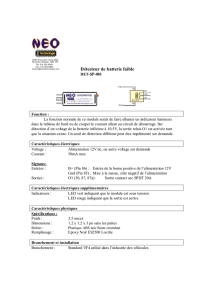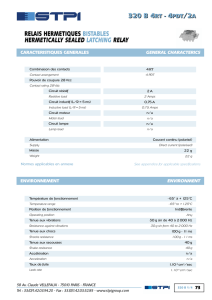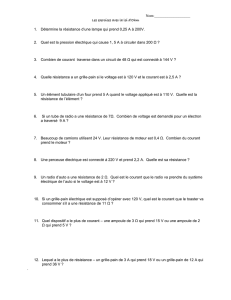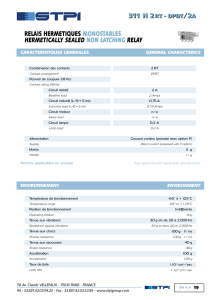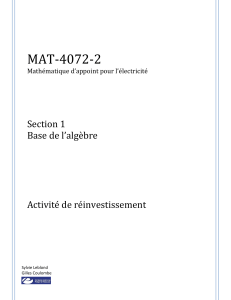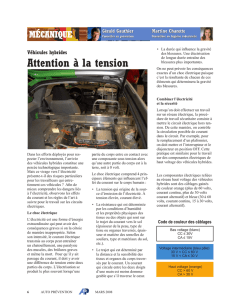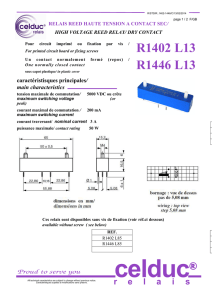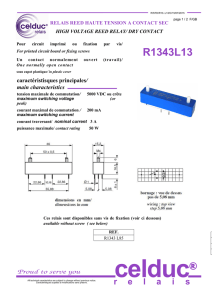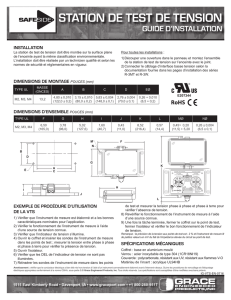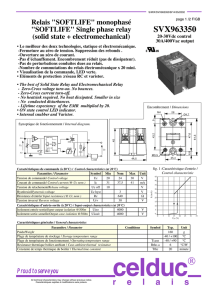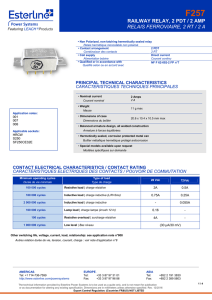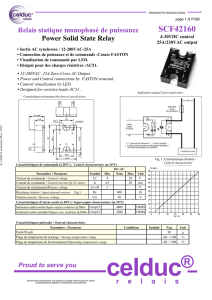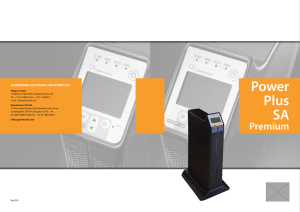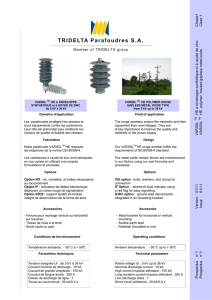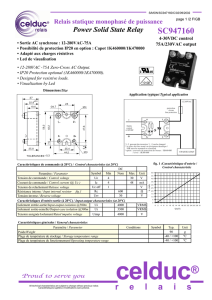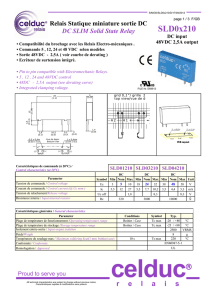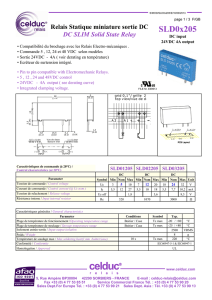regulateur - avr
publicité
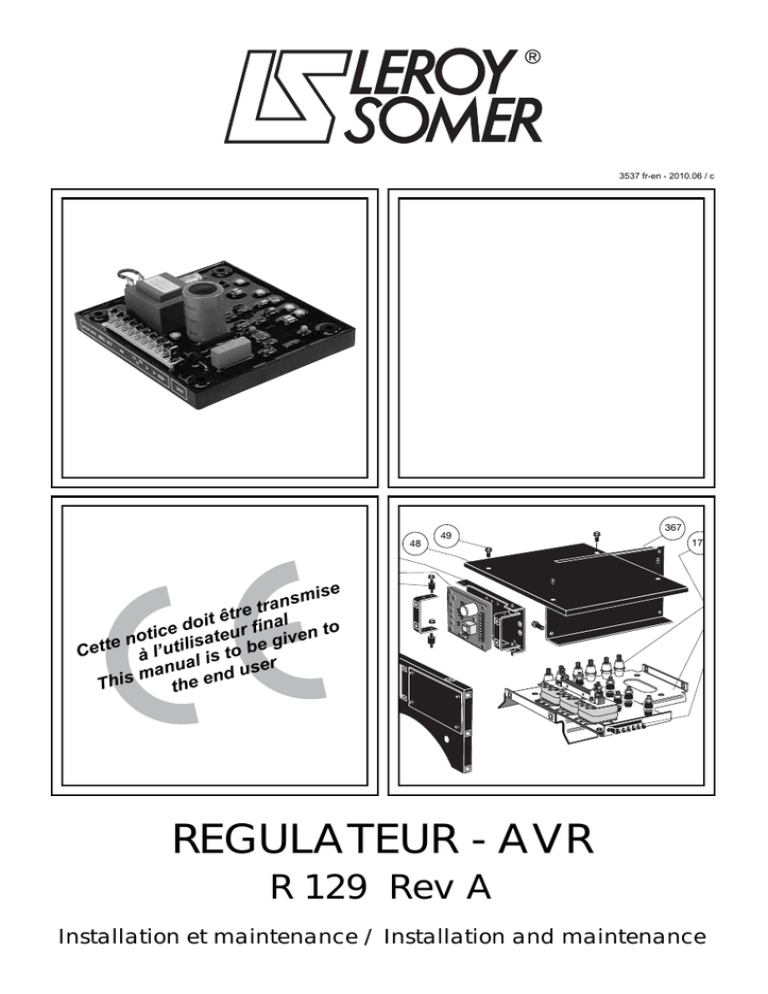
3537 fr-en - 2010.06 / c 48 49 367 172 mise trans e r t ê nal doit tice sateur fi given to o n i Cette à l’util is to be l a u ser n ma nd u s i h T t he e REGULATEUR - AVR R 129 Rev A Installation et maintenance / Installation and maintenance LEROY-SOMER Installation et maintenance / Installation and maintenance 3537 fr-en - 2010.06 / c REGULATEUR - AVR R 129 Rev A SOMMMAIRE / CONTENTS 1 - Régulateur de tension R 129 / Automatic Voltage Regulator R 129 ............................3 1.1 - Description / General ..................................................................................................3 1.2 - Caractéristiques / Regulators data .............................................................................4 1.3 - U/F ..............................................................................................................................5 1.4 - Réglage du régulateur R 129 / Adjustment of R 129 ..................................................5 2 - Procédure de réglage avec R 129 / Adjustment process with A.V.R. R129 ...............7 2.1 - Appareils de mesure nécessaires / Control instrument ..............................................7 2.2 - Branchements initiaux / Initial tappings ......................................................................7 2.3 - Réglage à vide / Adjustment at no load ......................................................................7 2.4 - Réglage en charge / Adjustment with load .................................................................8 2.5 - Fonctionnement / Operation .......................................................................................8 3 - Vérification statique du régulateur R 129 seul / Static check of the voltage regulator R 129 single ....................................................... 9 4 - Transformateur de compoundage / Compounding transformer (current transformer).... 10 4.1 - Aspect et schéma / Outline and diagram ..................................................................10 4.2 - Principe de réglage du transformateur de compoundage (sans régulateur) / Adjustment means on the compounding transformer (without A.V.R.)......................11 5 - Marche en parallèle / Parallel operation .......................................................................16 5.1 - Avec régulateur R 129 / With regulator R 129 ..........................................................16 5.2 - Marche en parallèle permanente avec le réseau avec régulateur R 726 / Continuous operation in parallel with the mains with regulator R 726 ......................16 5.3 - Marche en parallèle permanente avec le réseau avec régulateurs série R 200 / Continuous operation in parallel with the mains with regulators of range R 200 ......16 6 - Réglages du système d’excitation sans régulateur avec rhéostat / Excitation system adjustment without regulator .........................................................16 6.1 - Description de l'action du rhéostat / Description of the rheostat action ....................16 6.2 - Organigramme de réglage du système d'excitation / Adjustment procedure of the compound excitation ......................................................................17 6.3 - Consignes de réglages / Adjustment instructions .....................................................19 6.4 - Réglages de tension à l'utilisation (sur le site) / Voltage adjustment on site ............20 7 - Repérage des phases du bobinage auxiliaire par rapport aux phases du stator/ Identification of auxiliary winding phases in relation to stator phases.....................20 2 LEROY-SOMER Installation et maintenance / Installation and maintenance 3537 fr-en - 2010.06 / c REGULATEUR - AVR R 129 Rev A 1 - REGULATEUR DE TENSION R 129 ATTENTION : IL EST DANGEREUX DE PROCÉDER Á UN ESSAI DIÉLECTRIQUE SUR L'ALTERNATEUR SANS DÉBRANCHER TOUTES LES LIAISONS AU RÉGULATEUR. LES DOMMAGES CAUSÉS AU RÉGULATEUR DANS DE TELLES CONDITIONS NE SONT PAS COUVERTS PAR NOTRE GARANTIE. 1 - AUTOMATIC VOLTAGE REGULATOR R 129 CAUTION: IT IS HAZARDOUS TO PROCEED TO ANY HIGH VOLTAGE TEST ON THE ALTERNATOR WITHOUT HAVING PREVIOUSLY DISCONNECTED ALL CONNECTIONS TO VOLTAGE REGULATOR. DAMAGES OCCURING TO AVR IN SUCH CONDITIONS WILL NOT BE CONSIDERED IN A WARRANTY CLAIM. 1.1 - Description 1.1 - General Les composants électroniques montés dans un boîtier plastique sont enrobés dans un élastomère opaque. Le raccordement se fait à partir de languettes mâles "Faston" 6,3. Le régulateur comprend : - un bornier principal J1 (10 bornes repérées) - 2 borniers secondaires J2 et J3 (2 bornes repérées) - un potentiomètre de statisme : P1 - un potentiomètre de tension : P2 - un potentiomètre de stabilité : P4 - un potentiomètre Exc maxi : P5 - un potentiomètre statisme interne : P3 - ST1 50 Hz - 60 Hz - ST2 avec ou sans R 731 The PC board with electronic components is located inside an insulating plastic box and embeded in elastomere resin.Terminals consist in 1/4" "Faston" lugs. For connections and adjustments are: - main terminal strip J1 (10 marked terminal) - 2 terminal strips J2 and J3 (2 marked terminals) - potentiometer (screw) droop : P1 - potentiometer (screw) voltage : P2 - potentiometer (screw) stability : P4 - potentiometer (screw) excitation ceiling: P5 - potentiometer (screw) internal voltage droop: P3 - ST1 50 Hz - 60 Hz - ST2 with or without R 731 3 LEROY-SOMER Installation et maintenance / Installation and maintenance 3537 fr-en - 2010.06 / c REGULATEUR - AVR R 129 Rev A 1.2 - Caractéristiques 1.2 - Regulators data 1.2.1 - Fonction de base 1.2.1 - Basic fonction Nota : * : S.A.H. : Sens anti-horaire * : S.H. : Sens horaire - Régulateur soustractif (dérivation de courant) - Régulation de tension ± 1% entre marche à vide et pleine charge (non déformante) à vitesse et température stabilisées. - Plage de réglage de tension du potentiomètre interne. - Entrée mesure 220 V : 170 à 250 V - Entrée mesure 380 V : 340 à 500 V - Potentiomètre extérieur : 470Ω - 1W (réglage ± 10%). - Détection monophasée 2 VA isolée par transformateur, option module de détection triphasé (R...) raccordée à l'entrée "potentiomètre extérieur". - Puissance contrôlée nominale (courant continu) : 90V.7A - En crête (10 secondes) : 100V.10A. - Courant dérive nominal : 4 A crête 10 A. Note: * : CCW : Counter clockwise * : CW : Clockwise - Negative action A.V.R. (diverting excitation current) - Voltage accuracy ±1% between no-load and full rated load (not distorting) with stabilized speed and temperature. - Voltage range adjustment with internal potentiometer (P2) - Sensing input 220V: 170 to 250 V - Sensing input 380V: 340 to 500 V - Remote trimmer 470Ω-1W (Range ± 10%) - Sensing input power 2VA, single phase, insulated by transformer. Optionnal three phase sensing module (R...) connected in lieu of remote trimmer. - Rated controlled power (DC): 90V-7A Peak power (10 seconds): 100V - 10A - Rated diverted current 4 Amp, peak 10 A. 1.2.2 - Fonctions supplémentaires 1.2.2 - Additionnal functions - Marche en parallèle avec d'autres alternateurs, 2 possibilités sont offertes : - entre machines identiques ; statisme interne (proportionnel à la tension d'excitation), réglage par P3. - Universel ; avec T.I. (2 V.A. secondaire 1 A). Statisme proportionnel à la puissance réactive, réglage par P1. - Marche en parallèle avec le réseau, avec T.I. (2 VA, 1A) avec module additionnel (R180, R726) raccordé à l'entrée potentiomètre extérieur. - Limitation d'excitation Le potentiomètre (P5) permet de réduire la tension maximum d'excitation (réduction du courant de court-circuit permanent. - Paralleling with other alternators, 2 possibilities exist: - Between identical machines: internal droop (proportionnal to excitation voltage adjustable by (P3). - Universal, with C.T. connected (2 VA, secondary current 1A): quadrature droop (proportionnal to the reactive power) adjustable by (P1). - Paralleling with mains, with C.T. (2 VA, 1A) with additionnal modules (R180,R726) connected in lieu of remote trimmer. - Excitation ceiling The potentiometer (P5) enable to reduce the excitation ceiling voltage (reducing the sustained short circuitcurrent). 4 LEROY-SOMER Installation et maintenance / Installation and maintenance 3537 fr-en - 2010.06 / c REGULATEUR - AVR R 129 Rev A 1.2.3 - Potentiomètre extérieur : 470Ω-1W 1.2.3 - Remote trimmer 470Ω -1W Se branche à la place du strap J2. Ces 2 bornes permettent le raccordement d'un module extérieur en parallèle sur le réseau. (R726) ou d'un module de détection triphasé. May be connected in lieu of jumper J2. These 2 terminals also enable connection of a remote module for paralleling with the mains (R726) or a 3 phase sensing module. 1.2.4 - Le module R731 de détection triphasé se raccorde sur le bornier J3 après avoir coupé le strap ST2. 1.2.4 - The three phase sensing module R731 is connecting on terminals J3 after cutting the jumper ST2. 1.2.5 - Antiparasitage 1.2.5 - EMI Suppression Le régulateur répond à la norme V.D.E. 0875. classe : N. Module additionnel pour classe K. The regulator R 129 meets standard V.D.E. 0875. class: N. Optional module for class: K. 1.3 - U/F 1.3 - U/F - U/F ajuster par le strap ST1. - ST1 = 1 : coude 48 Hz - ST1 = 0 : coude 58 Hz - U/F adjusting by jumper ST1. - ST1 = 1: knee 48 Hz - ST1 = 0: knee 58 Hz Tension Voltage UN P2 Tension Voltage U/f 0,85 UN Fréquence ST2 Frequency 48 ou/or 58 Hz 0 ST3 fC 50 ou/or 60 Hz fN 1.4 - Réglage du régulateur R 129 1.4 - Adjustment of R 129 1.4.1 - Réglages du R 129 monté sur l'alternateur 1.4.1 - Adjustment of R 129 (factory mounted) - P1 est réglé au minimum soit en butée S.A.H.* - P2 est réglé selon la tension demandée - P1 (Quadrature droop with C.T.) is set to minimum: fully CCW* - P2 according requested voltage (400V if not specified) 5 LEROY-SOMER Installation et maintenance / Installation and maintenance 3537 fr-en - 2010.06 / c REGULATEUR - AVR R 129 Rev A Plage de tensions possibles : Branchement en 220 V : 170 V à 250 V Branchement en 380 V : 340 V à 525 V - Sélection 50 Hz ou 60 Hz : la sélection de la position du coude se fait en coupant le strap ST2, 50 Hz = 1, 60 Hz = 0. - P4 réglage optimisé aux essais pour un meilleur temps de réponse en transitoire sur impact et délestage de charge. - P5 réglage en fonction du courant de courtcircuit de la puissance d'excitation de l'inducteur. Plafond minimum de tension : 80 V. - P1 permet de régler le statisme pour un couplage en parallèle en absence de T.I. Il est réglé au minimum en butée S.A.H.* Possible voltages: Sensing input "200V": 170V to 250V Sensing input "380V": 340V to 525V - Selection 50 Hz or 60 Hz : the selection of knee position is doing to cutting the jumper ST2, 50 Hz = 1, 60 Hz = 0. - P4 optimized to get the best voltage recovery time - P5 excitation voltage ceiling: Mid pot - P1 (internal droop) set to a minimum: fully CCW if not specified. 1.4.2 - Réglage du R 129 (pièces détachées) 1.4.2 - Adjustment on spare A.V.R. R129 En sortie d'usine, les potentiomètres : P1, P5 et P3 sont normalement en butée au S.A.H.* - P2 est réglé pour la tension nominale (220 V ou 380 V selon le branchement) 1 - Ramener P2 en butée au S.A.H* et vérifier que P1, P5 et P6 le sont aussi. 2 - Vérifier l’état de ST2 : 50 HZ ou 60 Hz. 3 - Mettre le moteur d'entraînement à sa vitesse nominale. 4 - Mettre P4 au milieu de sa plage de réglage. 5 - Positionner P2 afin d'obtenir la tension désirée. 6 - Régler la vitesse d'entraînement du moteur à 48 Hz ou 58 Hz ou toute autre fréquence. 7 - Pour effectuer le réglage de la stabilité P4, mettre l'alternateur en charge. Effectuer des délestages et des à coups de charge ; en cas d'oscillations, agir sur P4 dans un sens ou dans l'autre jusqu'à la stabilité (renouveler cette opération plusieurs fois) 8 - Le courant de court-circuit se règle par 6 - P1, P5, P3 fully CCW - P2: rated sensing voltage (220 or 380 V according to connection) 1- Set P2 fully CCW and check if P1, P5, P6, are the same. 2 - Checking ST2 : 50 HZ or 60 Hz. 3- Drive the generator at rated speed 4- Set P4 Mid popt 5- Set P2 to get the wanted voltage 6- Drop speed to get 48 or 58 Hz (for 50 or 60 rated) 7- Stability setting. Make some step loading / unloading. Voltage should recover without hunting. If not try again by rotating P4 either CW or CCW until it becomes satisfactory. 8- Sustained short circuit current adjustable with P5 (ceiling excitation) fully CW: maximum 9 - Parallel operation Ajustment of voltage droop P1: with C.T. connected (quadrature droop) P3: internal droop (proportional to excitation voltage) * : CCW: Counter clockwise * : CW : Clockwise LEROY-SOMER Installation et maintenance / Installation and maintenance 3537 fr-en - 2010.06 / c REGULATEUR - AVR R 129 Rev A P5. 9 - Le statisme pour la marche en parallèle se règle par P1 ou P3. 2 - PROCEDURE DE REGLAGE AVEC R 129 2 - ADJUSTMENT PROCESS WITH A.V.R. R129 2.1 - Appareils de mesure nécessaires 2.1 - Control instrument Sur le régulateur : - Ampèremètre à courant continu analogique pour mesurer I R (E-,E-) calibre 1 Amp - Voltmètre à courant continu analogique pour mesurer U exc calibre : 30V - Voltmètre alternatif pour mesurer U d (bornes 0, 220V ou 0, 380V) Sur la sortie : - Wattmètre : KW ~ en charge Sur l'armoire de contrôle : - Frequencemètre : f ou tachymètre - Voltmètre alternatif : U alt (tension alternateur) - Ampèremètre : I ~ en charge Autres : - Grippe - fils (mesure I R, U exc). Checks on the A.V.R: - D.C. index ammeter to measure I R (E-, E-) Calib: 1 Amp - D.C. index voltmeter to measure U exc calib 30V D.C. - A.C. voltmeter to measure the voltage sensed by the A.V.R (0-220V, 0-380V terminal) On alternator output - Wattmeter: KW (load parameters) Normally on the control panel: - Frequencymeter: f or tachometer - A.C. Voltmeter: U alt (generator output) - Ammeter: I ~ (load parameter) Other: - Gripping clips (measurement of I R, U exc). 2.2 - Branchements initiaux Vérifier les connexions en se référant au schéma de branchement interne de la machine. Le transformateur de compoundage doit être branché suivant les connexions "100 %" (cf § 4 - 2 - 2). L'entrefer doit être faible (0,5 mm) et équilibré. 2.2 - Initial tappings Check connections by refering to the internal connection diagram of the machine. The secondaries of compounding transformer must be tapped "100 %" (see ¡× 4 - 2 - 2). The air gap must be weak (ab. 0,5 mm) and shared. 2.3 - Adjustment at no load 2.3 - Réglage à vide Faire tourner l'alternateur à sa vitesse à vide (Voir tableau de décision) - Liste des actions et défauts - Noter les valeurs IRØ du courant dérivé par le régulateur et U ExcØ de la tension d'excitation à vide. Drive the alternator at rated speed (See diagnosis chart ) - Listing of actions and faults. - Record the values IRØ of the diverted current and U excØ of the excitation voltage. 7 LEROY-SOMER Installation et maintenance / Installation and maintenance 3537 fr-en - 2010.06 / c REGULATEUR - AVR R 129 Rev A 2.4 - Adjustment with load 2.4 - Réglage en charge (L'alternateur est supposé avoir été réglé à vide à UN) - Faire tourner l'alternateur à sa vitesse nominale à vide. - Noter les valeurs IRØ. - Si la charge nominale n'est pas disponible appliquer une charge suffisamment importante (≥ 30 % Sn) et inductive (cos Ø ≤ 0,9 AR). - Noter les valeurs de tensions aux bornes de l'alternateur (U alt C), du courant dérivé (IRC) et de la tension d'excitation (U exc C). (Voir tableau de décision). (The alternator is supposed to have been adjusted at no load at UN) - Drive the alternator at rated speed, no load. - Record the values of current (IRØ) - If the rated load is not available, apply a sufficient (≥ 30 % Sn) and inductive (P.F ≤ 0,9 LAG) load - Record the voltages across alternator terminal (U altC) the diverted current (IRC), and exciter field voltage (Uexc C) - (See diagnosis chart). I R Courant dérivé Diverted current U exc CosØ = 0,8 Tension d'excitation Excitation Voltage U exc (E+,E-) CosØ =1 20 Conditions normales de réglage Normal adjustment U excC CosØ =1 U exc Ø 6 IRC 1A CosØ = 0,8 I R (E-,E-) IRØ 0 (Test conditions) 100 % S/SN Charge / Load 0,25 2.5 - Fonctionnement 2.5 - Operation Le régulateur est capable de dériver 4 A en continu et 10 A en pointe : le courant dérivé est haché et la puissance dissipée ne dépasse pas 50 W. Le moyen de contrôler l'action du régulateur est de mesurer le courant (I R) dérivé par le régulateur et la tension (U exc) d'excitation (bornes E+,E- du régulateur). Utiliser des appareils de mesure continu (cal = 1-3 A et 30 V) à galvanomètre pour mesures de tensions et courants hachées. The A.V.R may divert 4 A continuously and 10 A peak: the diverted current is chopped and the heat rejection is less than 50 Watt. The way to check the proper operation of voltage regulator is to measure current (IR) diverted by A.V.R. and the excitation voltage (U exc) (terminals E+ and E- of A.V.R). Use analogical moving coil meters (cal 1-3 A and 30 v - DC) to measure chopped voltages/currents. 8 LEROY-SOMER Installation et maintenance / Installation and maintenance 3537 fr-en - 2010.06 / c REGULATEUR - AVR R 129 Rev A R 129 +RED +E -E S2 S1 10 9 8 7 + E+ Inducteur / Exciter field + E- V Uexc (30V-D.C.) I r (1A-D.C.) + A - - ~ ~ ~ Compound Pont redresseur Rectifier bridge 6 5 0 4 V Ud (300-500V - A.C.) 3 220 2 380 1 Sensing Pour un réglage correct et dans les conditions normales de fonctionnement du compound, le rapport Uexc/Ir, à vide ou en charge doit être compris entre 20 et 30 (réglage usine 25) exemple : à vide en charge IR (A) 0,22 - 0,33 0,73 - 1,1 U exc (V) 6,5 22 U exc /Ir 20...30 20...30 In normal operation conditions and for a proper adjustment of compound system, the ratio Uexc/Ir on load or no load, must be between 20 and 30 ( factory adjustment about 25) i.e.: U alt (V) 400 400 FREQUENCE (Hz) 51,5 50 no load on load I R = 0 signifie que le régulateur ne dérive rien : a) - Excitation compound insuffisante b) - Réglage tension trop haut (régulateur) Uexc/Ir < 5 signifie que le régulateur ne peut pas dériver davantage : a) - Excitation compound trop forte b) - Réglage tension trop bas (régulateur) I R = 0 means that the regulator diverts nothing: a) - Compound set too low b) - Voltage adjusted too high (regulator) Uexc/Ir< 5 means that the regulator cannot divert any more: a) - Compound set too high b) - Voltage adjusted too low (regulator) 3 - VÉRIFICATION STATIQUE DU RÉGULATEUR R 129 SEUL 3 - STATIC CHECK OF THE VOLTAGE REGULATOR R 129 SINGLE - Relier la détection de tension (bornes 0V -220V, or 0V- 380V suivant la tension) à un réseau alternatif. - Raccorder une batterie avec une lampe en série L2 comme indiqué. - Raccorder une lampe en série L1 en sortie E+, E- du régulateur. - Tourner le potentiomètre tension (P2) de la position "à fond à droite" à la position "à fond à gauche", puis de nouveau "à fond à droite" : La lampe doit s'allumer puis s'éteindre. - Connect the voltage sensing (terminals 0V -220V,or 0V 380V according to voltage) to the A.C. mains. - Connect a battery with a lamp L2 in series as shown here after. - Connect a lamp L1 on output E+, E- of the A.V.R. - Turn the voltage potentiometer (P2) from "fully clockwise" to "fully anticlockwise", then in the reverse direction. - The lamp must brighten then dim. 9 LEROY-SOMER Installation et maintenance / Installation and maintenance 3537 fr-en - 2010.06 / c REGULATEUR - AVR R 129 Rev A - Si la lampe L1 reste toujours allumée ou toujours éteinte, quelque soit la position du potentiomètre, le régulateur est défectueux. La lampe L2 doit toujours rester allumée. * Nota : Attendre quelque secondes (10 à 30) l'allumage ou l'extinction de la lampe. - If the lamp remains bright or unlit whatever the position of pot (P2), that means that the regulator is defective. Lamp L2 must always be lit. * Note: Wait for 10...30 seconds the lamp lighting on or off. + +RED +E -E S2 S1 P4 P3 ST1 P2 P5 ST2 J3 Tension 470 - 1W J2 Batterie / Battery ; 12 ........48 V L1 . Lampe - Lamp : 12 .......48 V L2 . Lampe - Lamp : 12 .......48 V 0 P1 - R 129 180 .....250 V 360 ....500 V 220 380 Voltage } U R éseau Mains L2 L2 L1 L1 P2 P2 Dans le cas d'un potentiom ètre ext érieur - Court-circuiter les bornes J2 If remote trimmer was used - Short terminals J2 R-03 4 - TRANSFORMATEUR DE COMPOUNDAGE 4 - COMPOUNDING TRANSFORMER (CURRENT TRANSFORMER) 4.1 - Aspect et schéma 4.1 - Outline and diagram L3 L2 L1 W1 V1 U1 Secondaires / Secondaries 1 V2 100% C2 U2 T5 AV (D.E) C1 T4 W2 C3 T6 2 3 T2 15% 4 5 T1 AR (N.D.E) T3 6 Primaires / Primaries 10 5% LEROY-SOMER Installation et maintenance / Installation and maintenance 3537 fr-en - 2010.06 / c REGULATEUR - AVR R 129 Rev A 4.2 - Principe de réglage du transformateur de compoundage (sans régulateur) 4.2 - Adjustment means on the compounding transformer (without A.V.R.) Le transformateur de compoundage comporte deux moyens de réglages : - L'entrefer "E" du transformateur. - Le nombre de spires des secondaires "n". The compounding transformer has 2 possibilities for adjsutment: - the air gap "E". - the number of secondary turns. a) Ajustage de la tension U R à vide par réglage de l'entrefer a) Voltage adjustment at no load by adjusting the transformer air gap - Régler la vitesse à 3 ou 4 % au dessus de la vitesse nominale de l'alternateur U R. - Si la tension à vide est trop basse, il faut augmenter l'entrefer "E". Pour cela, débloquer l' écrou frein (1) et le contre écrou (2) et tourner la vis (3) à droite. - Si la tension à vide est trop élevée, il faut diminuer l'entrefer "E". Pour cela, débloquer l' écrou frein (1) et le contre écrou (2) et tourner la vis (3) à gauche, puis taper sur la culasse mobile (4). - Régler l'entrefer jusqu'à l'obtention d'une tension égale à la tension nominale, bloquer l'écrou frein (1) et le contre écrou (2). - Veiller à effectuer ces opérations sur les 2 étriers, de façon à obtenir un entrefer identique à 10 % près, sur toute la longueur du transformateur. - Adjust the speed at a value of 3 - 4 % above the rated speed. - If the voltage U R at no load is low, it is necessary to increase the air gap "E".Loosen the nut (1) and the locknut (2) and turn screw (3) to the right (clockwise). - If the voltage at no load is too high, it is necessary to reduce the air gap "E". Loosen the nut (1) and the locknut (2) and turn screw (3) to the left (anticlockwise), and push the adjustable yoke (4). - Adjust the air gap until a voltage equal to the rated voltage is obtained, then lock the nut (1) and the locknut (2). - The above operation must be carried out on both stirrups, to obtain the same air gap within about 10 % over the whole length of the transformer. 3 2 1 4 E 11 LEROY-SOMER Installation et maintenance / Installation and maintenance 3537 fr-en - 2010.06 / c REGULATEUR - AVR R 129 Rev A b) Ajustage de la tension U R en charge par le choix du nombre de spires secondaires b) Voltage regulation at load selecting the number of secondary winding turns Le réglage du rapport de transformation s'effectue en changeant les connexions d'entrées et de sorties des secondaires du transformateur. Chaque bobine secondaire comporte 3 enroulements séparés contenant "n" spires, 15 % "n" spires, et 5 % "n" spires. On peut donc régler le nombre de spires du secondaire entre "n" - 20 % et "n"+ 20 %, de 5 % en 5 %. Les dessins indiquent les 9 types de connexions possibles et le nombre de spires "n" correspondant. The transformation ratio is adjsuted by changing connections to the input terminals of the secondary windings. Each secondary coils has three separate windings consisting of "n" turns, 15 % "n" turns and 5 % "n" turns. Thus the number of turns in the secondary can be adjusted in step of 5 % from "n" - 20 % to "n" + 20 %. The drawing shows the nines types of possible connections, with the corresponding number of turns. Faire les mêmes connexions sur les 3 bobines. ATTENTION : Après toute modification du nombre de spires, il est nécessaire de refaire le réglage de l'entrefer à vide. Connect the 3 secondaries the same way. CAUTION: After any change of the turn number it is necssary to make again the adjustment of the airgap at no load. 12 LEROY-SOMER Installation et maintenance / Installation and maintenance 3537 fr-en - 2010.06 / c REGULATEUR - AVR R 129 Rev A Distribution table for number of turns in secondary coils of compounding transformer Répartition des spires dans les bobines secondaires du transformateur de compoundage (100 +15+5) 120 % 3 5 Vers bobinage auxiliaire To auxiliary winding 1 (100+15) 115 % 3 5 A (100+15-5) 110 % 1 1 3 5 A A B 2 4 6 6 Vers pont triphasé To rectifier B bridge 2 4 2 4 6 B (100+5) 105 % 5 100 % 1 3 5 A (100 -5) 95 % 1 3 5 A 1 3 A B 2 4 6 2 4 6 2 4 6 B B (100 -15 +5) 90 % 3 5 85 % A 1 3 5 A B 6 4 2 6 (100 -15 -5) 80 % (100 -15) 1 1 3 5 A B 4 2 6 4 2 B Si les bobines primaires ou secondaires sont bobinées à l'envers, ou si le bobinage auxiliaire du stator est connecté à l'envers, inverser les sorties et les entrées des bobinages secondaires. If primary or secondary coils are reverse wound, or secondary stator winding reverse connected then reverse the secondary coils inputs and outputs. 13 LEROY-SOMER Installation et maintenance / Installation and maintenance 3537 fr-en - 2010.06 / c REGULATEUR - AVR R 129 Rev A DIAGNOSIS CHART TABLEAU DE DECISION Symboles Réglage à vide / Adjustment at no load I R Ø - DC AMP Cas Case U alt < 0,10A 0,2-0,4 A > 0,5A 1 ~0 A1 N N 2 5 - 15 % UN F1 F2 N 3 40 - 60 % UN F3/F7 F4 F4 / F7 4 70 - 90 % UN A2/F7 A3 A3 5 95 - 100 % UN A2 A3 A3 + A4 6 UN (± 1 %) A2 A5 A4 7 100 - 105 % UN A3 + A2 A3 A3 + A4 8 110 - 115 % UN F5 A3 +A4 A4 + A3 9 120 - 135 % UN F5 F6 F6 10 Oscillations Hunting A6 A6/F12 A6/F12 Réglage en charge Alternator rated voltage Action to be made Fault to be cleared Impossible (check again) or and more than equal or more than much more than less than equal or less much less than between Adjustment with load U excC ≤ U exc Ø Cas Symbols Tension nominale altern. UN Action à entreprendre A Défauts F Impossible (tout vérifier) N ou / et + supèrieur à a>b supèrieur ou égal à a≥b beaucoup supérieur a >> b inférieur à a<b inférieur ou égal a≤b beaucoup inférieur a << b >a> compris entre U excC >>U exc Ø U alt I RC ≤ I RØ I RC >>I RØ I RC - DC AMP Case r = U excc / IRc < 0,1 A > 0,2 A r > 30 20 ≤ r≤ 30 r< 20 F2 A7 + F11 F2 F2 1 0 - 94 % UN F3 A7 + F11 2 94 - 98 % UN N A7 + F11 F9+F10 A8+F9+F10 3 98 - 102 % UN N A7 A7 A7 OK A8 4 102 - 106 % UN N F2+A7+F9 A7+F9+F10 A7+F9 F9+F10 A8+F10+F11 > 106 % UN N F5 F2 F2 F2 A8+F11 A7 A6/F12 A6/F12 A6/F12 5 6 14 Oscillations Hunting - A7 + F8 + F3 A7+F9+F10 A7+F10+F11 LEROY-SOMER Installation et maintenance / Installation and maintenance 3537 fr-en - 2010.06 / c REGULATEUR - AVR R 129 Rev A Actions : A1 : Amorcer à l'aide d'une batterie ( cf § 7 - 6 ) A2 : Augmenter l'entrefer du transformateur de compoundage (cf § 4 - 2) A3 : Régler la tension - sur le régulateur : potentiomètre (P2) - ou potentiomètre extérieur A4 : Diminuer l'entrefer du transformateur de compoundage (cf § 4 - 2) A5 : Réglage final à vide. I R doit être compris entre 0,2 et 0,4 A et le rapport Uexc/IR doit être compris entre 20 et 30 - Si Uexc/IR > 30 = A2 - Si Uexc/IR < 20 = A4 A6 : Régler la stabilité à l'aide du potentiomètre (P4) Nota : Le pompage peut être causé par des variations de vitesse (injecteurs ou régulateur de vitesse défectueux) A7 : Couper la charge et arrêter le groupe - Diminuer le nombre de spires secondaires sur le transformateur de compoundage (cf § 4 - 2) - Redémarrer et refaire le réglage à vide A8 : Couper la charge et arrêter le groupe - Augmenter le nombre de spires secondaires sur le transformateur de compoundage (cf § 4 - 2) - Redémarrer et refaire le réglage à vide Défauts : Actions: A1 : Flash the field with a battery (see § 7 - 6 ) A2 : Increase airgap of compounding transformer (see § 4 - 2) A3 : Adjust voltage - On the regulator, with pot (P2) - Or with remote voltage trimmer A4 : Decrease airgap of compounding transformer (see § 4 - 2) A5 : Final no load adjustment. I R must be between 0,2 and 0,4 A and the ratio Uexc/IR must be comprised between 20 and 30 - If Uexc/IR > 30 = A2 - If Uexc/IR < 20 = A4 A6 : Adjust Stability with pot (P4) on voltage regulator Note : Hunting may also be due to speed variations (defective injector or governor) A7 : Switch the load off and stop the genset - Decrease the number of secondary turns on the compounding transformer as indicated see § 4 - 2 - Restart and proceed to adjustment at no load A8 : Switch the load off and stop the genset - Increase the number of secondary turns on the compounding transformer as indicated see § 4 - 2 - Restart and proceed to adjustment at no load Faults: F1 : Circuit d'excitation coupé F2 : Défaut régulateur F3 : Défaut diodes tournantes, ou pont redresseur ou induit d'excitatrice F4 : Détection de tension mal branchée F5 : Régulateur non ou mal connecté ou en défaut F6 : Transformateur de compoundage mal raccordé (bobine 100 % non raccordé) ou en court circuit, ou mal adapté (rechange) F7 : Mauvais couplage du bobinage principal. F8 : Transformateur de compoundage mal raccordé ou en court circuit, ou mal adapté (rechange) F9 : Statisme interne ou satisme par T.I. en action. Tourner les potentiomètres P1 et P6 à fond à gauche F10 : La charge est déformante (ex: redresseurs, onduleurs) F 11 : Mauvais raccordement du transformateur de compoundage (non en phase). Vérifier les phases du bobinage auxiliaire par rapport au compound F 12 : Action intempestive du U/F Vérifier la fréquence - Vérifier l’état du ST2. F1 : Excitation circuit opened. F2 : Voltage regulator defective F3 : Failure in rotating diodes, rectifier bridge or exciter armature F4 : Voltage sensing wrongly connected F5 : Voltage regulator either wrongly or not connected or defective F6 : Compounding transformer wrongly connected (100% coil not in circuit) or in short circuit, or not adapted (wrong spare part) F7 : Bad connection of stator winding (terminal board). F8 : Compounding transformer wrongly connected or in short circuit, or not adapted (wrong spare part) F9 : Internal droop or quadrature droop acting - Turn potentiometers P1 and P6 fully anticlockwise F10 : The load is probably distorting (i.e. : rectifier, inverter) F11 : Wrong connection of auxiliary winding to compounding transformer . Check phase relation ship between auxiliary winding and compounding transformer primaries. F 12 : Undue action of U/F. Check frequency Check the state of ST2. O K : Réglage correct O K : Adjustment is correct 15 LEROY-SOMER Installation et maintenance / Installation and maintenance 3537 fr-en - 2010.06 / c REGULATEUR - AVR R 129 Rev A 5 - MARCHE EN PARALLÈLE 5 - PARALLEL OPERATION 5.1 - Avec régulateur R 129 5.1 - With regulator R 129 Consulter l'usine Consult factory 5.2 - Marche en parallèle permanente avec le réseau avec régulateur de Cos Ø additionnel R 726 5.2 - Continuous operation in parallel with the mains with additionnal P.F. regulator R 726 Demander la notice correspondante Ask for relevant handbook 5.3 - Marche en parallèle permanente avec le réseau, utiliser les régulateurs série R 200 5.3 - Continuous operation in parallel with the mains enable use of regulators of range R200 Demander la notice correspondante Ask for relevant handbook 6 - REGLAGES DU SYSTEME D'EXCITATION SANS RÉGULATEUR AVEC RHEOSTAT (MARCHE EN MANUEL) 6 - EXCITATION SYSTEM ADJUSTMENT WITHOUT REGULATOR (FAIL SAFE OPERATION) Les réglages de base du système compound se font pour la tension nominale U N correspondant au type du bobinage : par exemple pour le bobinage 1 couplage D la tension nominale est 400 V à 50 Hz et 480 V à 60 Hz. Nota : sans régulateur, la tension de l'alternateur varie comme la vitesse. The basic adjustment on the compounding excitation system have to be made for the rated voltage U N corresponding to the winding type: i e for winding nr 1, connection D (series Star) the rated voltage is 400 V at 50 Hz and 480 V at 60 Hz. Note: Without A V R, the alternator's output voltage varies as the speed. 6.1 - Description de l'action du rhéostat 6.1 - Description of the rheostat action Le rhéostat est branché en parallèle sur les inducteurs de l'excitatrice. Il est en série avec une résistance talon de 20 Ohms. Il comporte 3 secteurs de section différente. La position 0 correspond à "à fond à gauche" et 4/4 "à fond à droite" vu de l'axe de commande. The rheostat is connected in parallel with the exciter field. It is in series with a limiting resistor of 20 Ω and is divided in 3 sections of different cross section conductor Position 0 - fully anticlockwise Position 4/4 - fully clockwiwe. Seen from the setting side 16 LEROY-SOMER Installation et maintenance / Installation and maintenance 3537 fr-en - 2010.06 / c REGULATEUR - AVR R 129 Rev A 20 Ω 1/3 40 Ω 1/2 60 Ω 2/3 80 Ω 4/4 180 Ω L'équivalent de ce rhéostat en résistance réglable ou rhéostat à section constante est de 180 Ohms - 180 Watt (1A). Action Le rhéostat dérive une partie du courant d'excitation produit par le système compound. - La tension de l'alternateur augmente quand on tourne le rhéostat vers la droite. - Pour une même variation de la résistance, le rhéostat a beaucoup plus d'action sur la tension en charge que sur la tension à vide : la tension à vide ne doit pas être réglée en agissant sur le rhéostat, mais sur l'entrefer du transformateur de compoundage. 1/2 1/3 2/3 0 4/4 100 Ω 0 20 Ω Position 40 Ω Résistance totale Total resistance Résistance talon Limiting resistor 20 Ω Résistance totale Total resistance i max = 1 A The equivalent of this rheostat is an adjustable resistor, or constant cross section rheostat of 180 Ω - 180 Watt (1A). Action The rheostat diverts one part of the excitation current supplied by the compounding system. - The output voltage of the generator increase when the rheostat is rotated clockwise. - For the same variation of the resistance, the rheostat has much more action on the voltage on load than at no load: the no load voltage is not be adjusted with the rheostat, but by adjusting the air gap of the compounding transformer. 6.2 - Organigramme de réglage du système d'excitation compound sans régulateur avec rhéostat 6.2 - Adjustment procedure of the compound excitation system without AVR. with a rheostat Voir tableau page 19 pour les conditions de réglage. U T : Tension aux bornes de l'alternateur indiquée dans le tableau. U A : Tension alternateur. A l'arrêt 1) Raccorder les câbles de puissance suivant le schéma de branchement. 2) régler le rhéostat à 40 ou 60 Ω suivant les conditions de charge (tableau page 19). See table page 19 for testing conditions. U T: Output voltage of generator indicated in table. U A: Alternator's output voltage. Preliminary: 1) Connect power cable according to relevant diagram. 2) Preset the rheostat to 40 or 60 Ω according to the load conditions (see table page 19). 17 LEROY-SOMER Installation et maintenance / Installation and maintenance 3537 fr-en - 2010.06 / c REGULATEUR - AVR R 129 Rev A 3) Débloquer la culasse du transformateur de compoundage (page 19) pour pouvoir régler l'entrefer en marche. 4) Connecter les secondaires du transformateur de compoundage suivant le branchement 100 % (page 20). 3) Loosen the yoke of the compounding transformer (see page 19) to enable adjustment of air gap when running 4) Connect the secondaries of the compounding transformer according to the 100 % tapping (see table page 20). Démarrer le groupe électrogène - Régler la vitesse pour obtenir à vide 52 ou 63 Hz (ou la fréquence nominale à vide) Start the gen set - Adjust speed to get at no load 52 or 63 Hz (or the real no-load frequency) Redémarrer / Start again UA<UT Si impossible If impossible Redémarrer / Start again A vide - No load : F = 52 ou/or 63 Hz UA=UT U A~ - 1,3 U T UA>UT Diminuer l'entrefer Decrease air gap Augmenter l'entrefer Increase air gap STOP Si impossible If impossible Erreur de branchement du compound ou défaut (court-circuit) transfo de compoundage Wrong connection to compound transformer or short in secondary Erreur compound ,défaut des diodes tournantes ou pont redresseur Wrong compound transformer or failures (diodes, rectifier bridge) Appliquer la charge - Régler la vitesse / Apply the load - Adjust speed La tension de l'alternateur est très basse Voltage is very low En charge : F = 50 ou 60 Hz (quelques minutes de fonctionnement) On load : F = 50 ou 60 Hz (some minutes operation) Erreur de branchement du compound Permuter les entrées et les sorties des secondaires. Repérer les phases Wrong connection of compound transformer. Check phase position. Transpose input and output of secondaries Si impossible If impossible UA<UT STOP Diminuer le nombre de spires secondaire de 5 % Decrease number of secondary turns by 5 % UA=UT La tension de l'alternateur est très élevée Voltage is very high UA>UT STOP Erreur de branchement du compound. Repérage des phases Wrong connection of compounding transformer. Check phase position. Augmenter le nombre de spires secondaire de 5 % Increase number of secondary turns by 5 % Si impossible If impossible Délester la charge - Switch off the load REGLAGE TERMINE - Bloquer la culasse du transformateur de compoundage, à vide en maintenant UA = UT FINISHED ADJUSTMENTS - No load . Tighten the yoke of compounding transformer, taking care that UA remains equal to UT 18 LEROY-SOMER Installation et maintenance / Installation and maintenance 3537 fr-en - 2010.06 / c REGULATEUR - AVR R 129 Rev A 6.3 - Consignes de réglages Pour régler le système d'excitation compound, le rhéostat doit être amené à une position fixe qui dépend de la charge disponible pour le réglage et des conditions finales d'utilisation. - Si la charge dont on dispose pour faire les essais consomme suffisamment d'énergie réactive (Cos Ø 0,6 à 0,95 AR), c'est-à-dire si elle est constituée de moteurs électriques et que l'utilisation sur le site a aussi les mêmes caractéristiques : voir ligne A du tableau ci-dessous (conditions de réglage usine). - On ne dispose pour faire les réglages que d'une charge à Cos Ø =1 (résistance liquide par exemple) alors que la charge sur le site est à Cos Ø entre 0,6 et 0,95 AR : Voir ligne B. - Les réglages et l'utilisation sur le site sont à Cos Ø : 1 voir ligne C. - Si l'installation comporte des batteries de condensateurs pour la compensation globale du Cos Ø et qu'à un moment donné ces condensateurs se trouvent seuls alimentés par l'alternateur, il faut absolument débrancher les batteries de condensateur en service secours sur groupe électrogène car la tension de l'alternateur devient incontrôlable. 6.3 - Adjustment instructions with a rheostat To enable the proper adjustment of the compound system, the rheostat is preset to a fixed position (value) depending upon the load available for testing and the final conditions on site. - If the load available for testing is consuming enough reactive power (p.f. 0,6 to 0,95 LAG ) being made up of electric motors, chokes,..... and the site load conditions are the same, see line A of the following table (factory adjustments). - If the only available testing load is a p.f.:1 (i.e. liquid resistor tank) and, on site, the load is at p.f. 0,6 to 0,95 LAG, see line B. - If for testing and on site the p.f.: 1 see line C. - If on site, the p.f. of the plant is corrected with capacitors and it could happen that at any moment only these capacitors are supplied by the alternator it is absolutely necessary to disconnect the capacitors otherwise the voltage generator raises or drops helplessly. VALEURS A FROID - VALUES WHEN COLD U T : Tension à obtenir Voltage to be obtained Charges - load Réglages - Test Cos Ø A 0,6 à 0,95 AR/LAG Site - Site Cos Ø A vide No load En charge On load Rheostat Valeurs de réglage Site on test On site Ohm (position) Ohm (position) 0,6 à 0,95 AR/LAG UN (400 V) U N +2,5% (410 V) 60 (1/2) 60 (1/2) B 1 0,6 à 0,95 AR/LAG U N -2,5% (390 V) U N +2,5% (410 V) 40 (1/3) 60 (1/2) C 1 1 UN (400 V) U N +2,5% (410 V) 40 (1/3) 40 (1/3) Fréquences 52 Hz* 50 Hz Frequencies 63 Hz* 60 Hz 19 LEROY-SOMER Installation et maintenance / Installation and maintenance 3537 fr-en - 2010.06 / c REGULATEUR - AVR R 129 Rev A * Régler la vitesse pour obtenir 50 Hz ou 60 Hz en charge, la fréquence à vide indiquée doit être remplacée par la fréquence réelle à vide. * Adjust no-load speed so that to get 50 ou 60 Hz on load. The indicated no-load frequency must be replaced by the true noload frequency. 6.4 - Réglages de tension à l'utilisation (sur le site) 6.4 - Voltage adjustment on site Les réglages sur le site se font à l'aide du rhéostat qui : - permet de fonctionner à une tension différente de la tension réglage. - permet de s'adapter au Cos Ø réel de l'installation sauf pour Cos Ø 1 - voir réglage spécial. - permet de s'adapter au statisme réel du diesel - permet de compenser les variations dues à l'échauffement. Voltage adjustments on site are made with the rheostat which allows: - Operation at a voltage different to the factory - set - voltage. - Adaption to the real power factor of the consumers (except for p.f.:1, see special adjustment advice) - Adaption to the real speed droop of the engine. - Compensation for the variation in voltage due to temperature rise. 7 - REPERAGE DES PHASES DU BOBINAGE AUXILIAIRE PAR RAPPORT AUX PHASES DU STATOR 7 - IDENTIFICATION OF AUXILIARY WINDING PHASES IN RELATION TO STATOR PHASES Les essais pour repérer les phases du bobinage auxiliaire par rapport aux phases du stator, se font, l'alternateur fonctionnant à vide, le stator étant couplé en étoile. - Réaliser un neutre artificiel en branchant 3 résistances de 220 Ω - 10 W couplées en étoile, aux bornes du bobinage auxiliaire. - Relier comme indiqué dans le schéma page 35, le neutre de l'alternateur au neutre artificiel du bobinage auxiliaire. - Mesurer et noter les tensions : UPHN entre phase et neutre du bobinage stator. uphn entre phase et neutre du bobinage auxiliaire. U1, U2, U3, V1, V2, V3, W1, W2 et W3 entre les sorties du bobinage principale UVW et les sorties du bobinage auxiliaire marquées pour l'essai 1, 2, 3. The tests to identify the auxiliary winding phases in relation to the stator winding phases are carried out, with the stator star coupled. - Make an artificial neutral by connecting 3 resistors (220 Ω, 10 W) in star, to the output terminals of the auxiliary winding. - Connect the circuit as shown in the diagram below, with the alternator neutral connected to the auxiliary winding artificial neutral. - Measure and note the following voltages: UPHN between phase and neutral of the stator winding. uphn between phase and neutral of the auxiliary winding. U1, U2, U3, V1, V2, V3, W1, W2 and W3, between the main winding outputs UVW and the auxiliary winding outputs marked 1,2,3 for check purpose. 20 LEROY-SOMER Installation et maintenance / Installation and maintenance 3537 fr-en - 2010.06 / c REGULATEUR - AVR R 129 Rev A V U-1 V Neutre artificiel Artificial neutral uphn 220 Ω - 10 W L3 L2 L1 W1 V1 U1 Connexions étoile série (Code D) Series star connection (Code D) N 220 Ω - 10 W C2 V2 220 Ω - 10 W T3 T5 C1 U2 T2 T1 V UPHN T4 T6 Vers bobinages auxiliaires To auxiliary winding C3 W2 Supposons que UPHN = 220 V et que uphn = 22 V. Les résultats des mesures peuvent se présenter sous forme de 2 tableaux différents A ou B. - Le tableau A contient 3 valeurs de tension égales à 220 - 22 = 198 Volts et 6 valeurs égales à 220 + (22 x 0,45) = 230 Volts. Phase du bobinage principal Main winding phase U Assume that UPHN = 220 V and that uphn = 22 V. The resulting measurements may be presented in two different forms of table, A or B. - Table A contains 3 voltage values equal to 220 - 22 = 198 Volts and 6 values equal to 220 + (22x0,45) = 230 Volts. V W 1 198 230 230 1=U Marquage du bob.auxiliaire 2 230 230 198 2=W Aux. winding ident. marking 3 230 198 230 3=V - Le tableau B contient 3 valeurs de tension égales à 220 + 22 = 242 Volts et 6 valeurs égales à 220 - (22 x 0,45) = 210 Volts Phase du bobinage principal Main winding phase 1 - Table B contains 3 voltage values equal to 220 + 22 = 242 Volts and 6 values equal to 220 - (22x0,45) = 210 Volts U V W 210 242 210 1=V Marquage du bob.auxiliaire 2 242 210 210 2=U Aux. winding ident. marking 3 210 210 242 3=W Dans les 2 cas, les 3 tensions inférieures ou supérieures aux 6 autres permettent le repérage des phases du bobinage auxiliaire : la phase u du bobinage auxiliaire est celle qui présente la tension la plus petite par rapport In both cases, the three voltages which are less than or greater than the 6 other voltages may be used to identify the auxiliary winding phases: auxiliary winding phase u is the one with the lowest voltage in relation 21 LEROY-SOMER Installation et maintenance / Installation and maintenance 3537 fr-en - 2010.06 / c REGULATEUR - AVR R 129 Rev A à la phase U du bobinage principal dans le cas A, et celle qui présente la tension la plus grande par rapport à la phase U dans le cas B. Dans le cas A, le bobinage auxiliaire est en phase avec le bobinage principal : reconnecter le bobinage auxiliaire comme indiqué par le repère. Dans le cas B, le bobinage auxiliaire est en opposition de phase avec le bobinage principal : reconnecter le bobinage auxiliaire en permutant les entrées et sorties des secondaires du transformateur de compoundage. Remarque : Les 3 primaires du transformateur de compoundage doivent être connectés dans le même sens d'enroulement, sinon il n'y a pas de fonctionnement correct possible du système compound. Si, après repérage et reconnection comme indiqué ci-dessus, la tension de l'alternateur "s'écroule" pour une faible charge inductive, permuter les entrées et les sorties des secondaires du transformateur de compoundage. to main winding phase U, in example A, and has the greatset voltage in relation to phase U, in example B. In example A, the auxiliary winding is in phase with the main winding. Reconnect the auxiliary winding as indicated by the ident. marking In example B, the auxiliary winding is in opposite phase to the main winding. Reconnect the auxiliary winding, change over the compounding transformer secondary inputs and outputs. Note: The 3 primary winding of the compounding transformer must be connected in the same winding direction, otherwise correct operation of the compound system is not possible. The same is true for the secondary windings. After identification and reconnection as described above, if the alternator voltage "collapses" under a low inductive load, then change over the compounding transformer secondary winding inputs and outputs. U 230 r: (up 22 hn ) 2 (w) U 230 1 (u) 3 (v) 210 R : 220 ) (UPHN 210 3 (w) 1 (v) 2 (u) 8 19 W 24 2 Cas : A Example : A W V 100 Volts 22 R : 220 r : 22 (UPHN) (uphn) Cas : B Example : B V LEROY-SOMER Installation et maintenance / Installation and maintenance 3537 fr-en - 2010.06 / c REGULATEUR - AVR R 129 Rev A 23 MOTEURS LEROY-SOMER 16015 ANGOULÊME CEDEX - FRANCE 338 567 258 RCS ANGOULÊME S.A. au capital de 62 779 000 € www.leroy-somer.com
